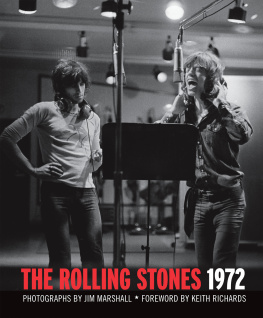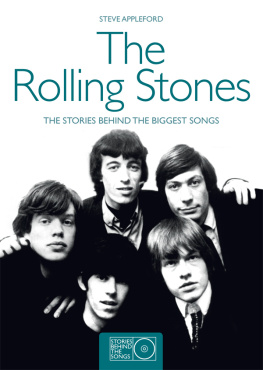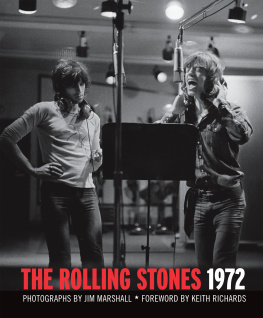Summer, 1972with the Beatles disintegrated and Bob Dylan semi-retired, the Rolling Stones stood, unchallenged, at the peak of the rock music world. Upstarts such as Led Zeppelin may have seized the day momentarilyStairway to Heaven was ubiquitous that spring as the recently released Led Zeppelin IV settled into a five-year run on the chartsbut the Stones still reigned supreme, exalted above all other rock stars. They had just released a two-record set in May, Exile on Main Street, that followed in the wake of three of the greatest rock albums everBeggars Banquet (1968), Let It Bleed (1969), and Sticky Fingers (1971).
The Rolling Stones cocaine- and tequila sunset-fueled 1972 tour would be rocks most glittering moment, with its four-million-dollar box office bigger than any before, and hangers-on the likes of best-selling author Truman Capote and Princess Lee Radziwill. The bands touring party on the private jet included its own doctor, trained in emergency medicine and always ready to write prescriptions, as well as photographer Robert Frank, who captured the mayhem on his Super 8 home movie cameras, edited into a never-released (but widely seen) feature film, Cocksucker Blues. There was Mick Jagger, ready for his close-up, and wasted Keith Richards, wearing a jacket with a Coke emblem and slouching under a sign reading Patience Please A Drug Free America Comes First! for photographer Ethan Russell. Annie Leibovitz, writer Robert Greenfield, and others, including Jim Marshall, joined the tour at various stages. They dubbed themselves STPStones Touring Partyand adopted the stickers from the automotive oil additive with the same acronym, with its double meaning as slang for a popular hallucinogenic drug in the psychedelic underground. They were like a pirate crew where everyone had drunk more than his share of grog. This was rock and roll at its greatest.

Mick Jagger at Sunset Sound, spring 1972, Los Angeles, California.

Jagger with Chris ODell, production assistant for the 1972 tour. ODell started her career at Apple Records with the Beatles, and after the 1972 tour went on to work with Dylan; Crosby, Stills, Nash & Young; and Linda Ronstadt as one of the first female tour managers.


Mick Jagger and Keith Richards at Sunset Sound doing post-production work on Exile on Main Street, spring 1972, Los Angeles, California.
The band recorded most of Exile on Main Street in the basement of Keith Richardss rented chateau in Nellcte, France, working with producer Jimmy Miller, but retreated to Los Angeles to finish the album at Sunset Sound. That old studio in the middle of Hollywood, where Annette Funicello made all her records, was started in the fifties by Walt Disneys music maestro, Tutti Camarata. Elektra Records practically turned it into a house studiothe Doors made several albums therebut the Stones had also worked the room before, on sessions for Beggars Banquet.
With the record due to be released in May and the eight-week, thirty-city tour set to start in June 1972, engineer Andy Johns spent many sleepless nights through the first three months of that year trying to bring the project across the finish line. Last-minute panic set in. The record went through a number of marathon remix sessions, overdubbing vocal parts and doing whatever might be needed to get the album out the door. On assignment for Life magazine, Jim Marshall traveled to Los Angeles and captured Mick and Keith lolling around the studio, also shooting a separate portrait session with Mick. These are precursors to the intimate backstage images Marshall captured from the tour itself.
This Stones tour pierced a veil for rock music. Life was mainstream press. The Rolling Stones had become famous beyond the subterranean cultural reaches of the rock-and-roll demimonde. Rock music itself was grandly ascendant, just beginning to flex its popular strength in those early post-Woodstock years, and the Rolling Stones were rocks biggest stars. This tour would be a victory lap under the brightest spotlight and upon the largest stage the Stones had ever known. Rock music would grow bigger, but it would never be greater than the Rolling Stones tour of America in 1972.
The tour began in Vancouver, Canada, where two thousand kids without tickets battled cops outside. The next night in Seattle, the band cut a few songs from the set and tightened up the show. Stevie Wonder was their opening act: a half-hour explosion of talent and soul from his opening drum solo to hopping off stage at the back of a conga line of tall, beautiful black female vocalists. The Stones cut their set down to under ninety minutes. After two successful shows in Seattle, the band was ready for San Francisco.
The taint of Altamont still lingered over the Stones, especially in the Bay Area. At the end of the 1969 tour, the band left town in a hurry after a planned free concert before an audience of near a half-million turned into a disaster. Members of the Hells Angels motorcycle club, hired for $400 worth of beer to act as security guards, beat the crowd with pool cues and even knocked out Jefferson Airplane vocalist Marty Balin during his performance earlier in the day. The Stones waited until sunset to take the stage, only to have the performance interrupted by fights and outbreaks in the crowd during Sympathy for the Devil. People died; one, Meredith Hunter, was killed directly in front of the stage. The band and their touring party took off after the concert in their overloaded helicopter like refugees fleeing Saigon.
In the aftermath, San Francisco rock impresario Bill Graham had some harsh words for Mick Jagger, but nonetheless had managed to coax the band into playing the Winterland for the 1972 tour. The 5,400-seat former ice rink where he held weekly rock concerts generally featured far-less-famous bands. In San Francisco the Stones first encountered the West Coast rock establishment, through musicians such as Jerry Garcia and Neil Young. John Lee Hooker came backstage to visit between shows. And, of course, there were the massesthe computer ticket agency reported more than 100,000 orders for the approximately 20,000 tickets available to the four shows. There also waited medianot just






















